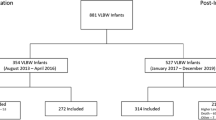Abstract
Objective:
To determine the impact of breast crawl on breast feeding and its feasibility and acceptability in a busy labor room.
Study Design:
A prospective, single blinded, randomized controlled clinical trial. Impact of breast crawl was studied in one group and the outcome was compared with the other group where breast crawl was not performed. Feasibility and acceptability was determined by analysis of questionnaire given to obstetricians and nurses. Descriptive statistics and χ2-analysis was applied to evaluate the questionnaire and to compare the outcome in the two groups.
Result:
Breast crawl had a significant positive impact on the onset of lactation (P=0.0005) as well as extent of neonatal weight loss on day 3 (0.032).
Conclusion:
Our study adds to the body of evidence that breast crawl results in positive short-term breast feeding outcome but acceptability of breast crawl as a routine in a busy labor room remains a major issue.
This is a preview of subscription content, access via your institution
Access options
Subscribe to this journal
Receive 12 print issues and online access
$259.00 per year
only $21.58 per issue
Buy this article
- Purchase on Springer Link
- Instant access to full article PDF
Prices may be subject to local taxes which are calculated during checkout
Similar content being viewed by others
References
Gomez P, Baiges N, Batiste F, Marca G, Nieto J, Closa M . Kangaroo method in delivery room for full-term babies (in Spanish). An Esp Pediatr 1998; 48: 631–633.
Bornstein M . Sensitive periods in development. Structural characteristics and causal interpretation. Psychol Bull 1989; 105: 179–197.
Langercrantz H, Slotkin TA . The ‘stress of being born’. Sci Am 1986; 92–102.
Langercrantz H . Stress, arousal and gene activation at birth. News Physiol Sci 1996; 11: 214–218.
Porter RH, Winberg J . Unique salience of maternal breast odors for newborn infants. Neurosci Biobeh Rev 1999; 23: 439–449.
Porter RH . The biological significance of skin-to-skin contact and maternal odors. Acta Paediatr 2004; 93: 1560–1562.
Awi DD, Alikor EA . The influence of pre- and post-partum factors on the time of contact between mother and her new-born after vaginal delivery. Niger J Med 2004; 13 (3): 272–275.
Bergman NJ, Linley LL, Fawcus SR . Randomized controlled trial of skin-to-skin contact from birth versus conventional incubator for physiological stabilization in 1200 to 2199 gram newborns. Acta Paediatr 2004; 93: 779–785.
Varendi H, Porter RH, Winberg J . Does the newborn baby find the nipple by smell? Lancet 1994; 344 (8928): 989–990.
Varendi H, Porter RH, Winberg J . Attractiveness of amniotic fluid odor: evidence of prenatal olfactory learning? Acta Paediatr 1996; 85 (10): 1223–1227.
Varendi H, Porter RH . Breast odour as the only maternal stimulus elicits crawling towards the odour source. Acta Paediatr 2001; 90 (4): 372–375.
Widström AM, Wahlberg V, Matthiesen AS, Eneroth P, Uvnäs-Moberg K, Werner S et al. Short-term effects of early suckling and touch of the nipple on maternal behaviour. Early Hum Dev 1990; 21 (3): 153–163.
Christensson K, Siles C, Moreno L, Belaustequi A, De la Fuente P, Lagercrantz H et al. Temperature, metabolic adaptation and crying in healthy full-term newborn infants cared for skin-to-skin or in a crib. Acta Paediatr 1992; 81 (6–7): 488–493.
Christensson K, Cabrera T, Christensson E, Uvnäs-Moberg K, Winberg J . Separation distress call in the human neonate in the absence of maternal body contact. Acta Paediatr 1995; 84 (5): 468–473.
Matthiesen AS, Ransjö-Arvidson AB, Nissen E, Uvnäs-Moberg K . Postpartum maternal oxytocin release by newborns: effects of infant hand massage and sucking. Birth 2001; 28 (1): 13–19.
Klaus M . Mother and Infant: early emotional ties. Pediatrics 1998; 102 (5 Suppl E): 1244–1246.
Elizabeth R . Moore gene cranston anderson, randomized controlled trial of very early mother–infant. Skin-to-skin contact and breastfeeding status. J Midwifery Womens Health 2007; 52: 116–125.
Moore ER, Anderson GC, Bergman N, Dowswell T . Early skin-to-skin contact for mothers and their healthy newborn infants. Cochrane Database Syst Rev 2003 (2): CD003519.
Mahmood I, Jamal M, Khan N . Effect of mother-infant early skin-to-skin contact on breastfeeding status: a randomized controlled trial. J Coll Physicians Surg Pak 2011; 21 (10): 601–605.
Chapman DJ, Pérez-Escamilla R . Identification of risk factors for delayed onset of lactation. J Am Diet Assoc 1999; 99 (4): 450–454.
Richard L, Alade MO . Effect of delivery room routines on success of first breast feed. Lancet 1990; 336 (8723): 1105–1107.
Bramson L, Lee JW, Moore E, Montgomery S, Neish C, Bahjri K et al. Effect of early skin-to-skin mother—infant contact during the first 3 hours following birth on exclusive breastfeeding during the maternity hospital stay. J Hum Lact 2010; 26 (2): 130–137.
Marín Gabriel MA, Llana Martín I, López Escobar A, Fernández Villalba E, Romero Blanco I, Touza Pol P . Randomized controlled trial of early skin-to-skin contact: effects on the mother and the newborn. Acta Paediatr 2010; 99 (11): 1630–1634.
Maisels MJ, Gifford K, Antle CE, Leib GR . Jaundice in the healthy newborn infant: a new approach to an old problem. Pediatrics 1988; 81: 505–511.
Manganaro R, Mami C, Marrone T, Marseglia L, Gemelli M . Incidence of dehydration and hypernatremia in exclusively breast-fed infants. J Pediatr 2001; 139: 673–675.
Dewey KG, Nommsen-Rivers LA, Heinig MJ, Cohen RJ . Risk factors for suboptimal infant breastfeeding behavior, delayed onset of lactation, and excess neonatal weight loss. Pediatrics 2003; 112 (3 Part 1): 607–619.
Acknowledgements
We acknowledge the role of Dr Prashant Gangal and the website www.breastcrawl.org in introducing us to the wonderful concept of breast crawl.
Author information
Authors and Affiliations
Corresponding author
Ethics declarations
Competing interests
The authors declare no conflict of interest.
Rights and permissions
About this article
Cite this article
Girish, M., Mujawar, N., Gotmare, P. et al. Impact and feasibility of breast crawl in a tertiary care hospital. J Perinatol 33, 288–291 (2013). https://doi.org/10.1038/jp.2012.109
Received:
Revised:
Accepted:
Published:
Issue Date:
DOI: https://doi.org/10.1038/jp.2012.109


